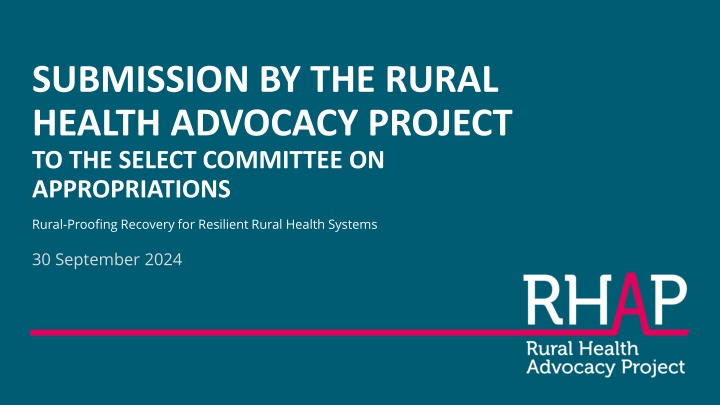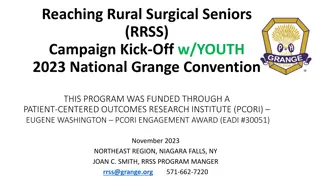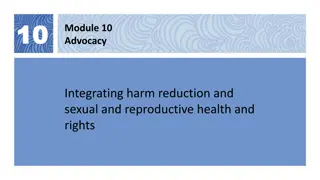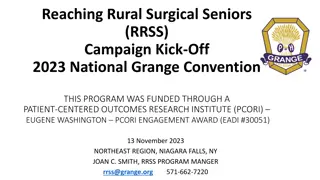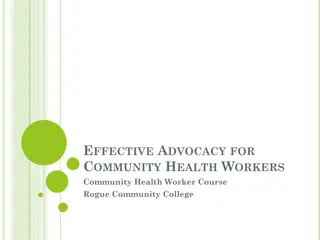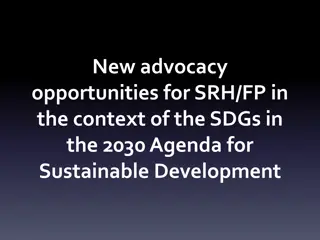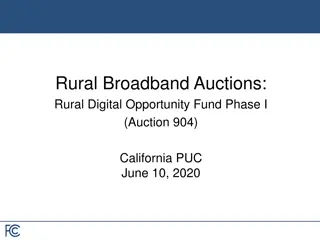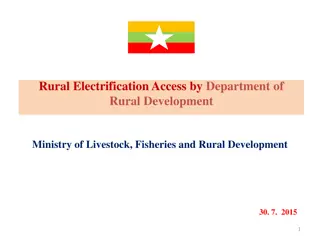Challenges and Opportunities in Rural Health Advocacy
The Rural Health Advocacy Project submitted a crucial report to the Select Committee on Appropriations outlining the impact of uncertain economic conditions on rural health systems. The report discusses the implications of the Medium-Term Budget Policy Statement (MTBPS) for rural health funding and highlights the importance of protecting access to healthcare services in times of financial constraints. It emphasizes the need for proactive measures to rural-proof recovery and build resilient rural health systems.
Download Presentation

Please find below an Image/Link to download the presentation.
The content on the website is provided AS IS for your information and personal use only. It may not be sold, licensed, or shared on other websites without obtaining consent from the author.If you encounter any issues during the download, it is possible that the publisher has removed the file from their server.
You are allowed to download the files provided on this website for personal or commercial use, subject to the condition that they are used lawfully. All files are the property of their respective owners.
The content on the website is provided AS IS for your information and personal use only. It may not be sold, licensed, or shared on other websites without obtaining consent from the author.
E N D
Presentation Transcript
SUBMISSION BY THE RURAL HEALTH ADVOCACY PROJECT TO THE SELECT COMMITTEE ON APPROPRIATIONS Rural-Proofing Recovery for Resilient Rural Health Systems 30 September 2024
MTBPS 2022 MTBPS was tabled at a time of significant uncertainty , at a global level we have transition from the covid crisis to war Rising fuel and food costs along with rising interest rates ,high inflation , low growth constrained energy supply contribute to a treasuries weak growth outlook The exclusion of provisions for the Eskom debt or public sector wage increases have increased uncertainty on future funding flows for health and rural health in particular 2 | 30 September 2024
MTBPS 2019/20 2020/21 Outcome 2021/22 2022/23 Revised 2023/24 Medium-term estimates 2024/25 2025/26 R billion Division of available funds National departments of which: Provincial indirect grants Local indirect grants Provinces Equitable share Conditional grants Local government Equitable share General fuel levy sharing with metropolitan municipalities Conditional grants Provisional allocations not assigned to votes1 Unallocated reserve Projected underspending Non-interest allocations Debt-service costs Contingency reserve Main budget expenditure Percentage shares National departments Provinces Local government 1. Includes support to Eskom, amounts for projects approved through Budget Facility for Infrastructure and other provisional allocations 749,8 790,5 823,0 857,9 817,7 822,2 859,1 2,9 5,6 2,9 4,1 660,8 544,8 116,0 135,6 76,2 14,6 3,7 5,7 684,5 560,8 123,7 154,2 87,3 15,3 4,6 8,2 4,2 9,9 4,4 10,7 709,5 576,5 133,0 174,6 102,4 4,8 14,0 743,3 602,9 140,4 183,5 109,4 613,4 505,6 107,9 123,0 65,6 13,2 628,8 520,7 108,1 137,1 83,1 14,0 684,3 556,4 128,0 164,9 95,1 15,4 16,1 16,8 44,2 40,0 44,8 51,5 14,8 54,4 36,5 56,1 38,0 57,3 39,3 1 486,2 204,8 1 691,0 1 556,4 232,6 1 789,0 1 619,4 268,1 1 887,5 1 703,4 332,2 2 041,6 1 785,6 352,9 2 144,5 41,3 1 872,5 380,7 2 263,2 47,3 -5,9 1 705,5 307,7 2 018,2 5,0 6,0 6,0 10,0 50,4% 41,3% 8,3% 50,8% 40,4% 8,8% 50,8% 40,8% 8,4% 50,6% 40,3% 9,1% 49,1% 41,1% 9,9% 48,2% 41,6% 10,2% 48,1% 41,6% 10,3% 3 | 30 September 2024
Health Care Allocations Health care services are delivered by provinces and is funded primarily through provincial equitable share allocations Equitable share allocations reduce in the 2023/4 financial year then rise in the outer years However, if economic conditions deteriorate further , public sector wages increase above 3 % there is a risk that service capacity in health departments will decline further The constitution of the republic places a responsibility on the state to progressively expand access to health care and parliament has a duty to protect access to health especially in times of fiscal constraints 4 | 30 September 2024
RHAPs Position Realising the right to healthcare access should be understood through achieving Universal Health Coverage (UHC); defined by access, quality and affordability of healthcare for all Deepening quality of healthcare for the few cannot be prioritised over increasing access to healthcare for the majority; this is neither ethical or efficient. For South Africa, this largely requires better investment in primary healthcare (PHC) services, and focus on rural areas; which suffer historical and ongoing low service coverage. Rethinking how an adequate healthcare workforce, relevant health information systems and responsive budgeting mechanisms can be coordinated under good governance and values offers the possibility of building resilient health systems, reducing vulnerability to shocks and deepening South Africans health and wellbeing. By 2016/17, our UHC Service Coverage Index (which excludes financial risk protection) was calculated at 56.9, versus the global average of 66 and 2030 goal of attaining full coverage at 100. Effects of Covid will have certainly regressed even this level of progress. As RHAP, we see government s responsibility as ensuring the optimization of current health spending to secure a more equitable access to primary healthcare (PHC), towards universal health coverage (UHC). This requires a human rights budgeting framework which more intentionally aligns economic policy with socioeconomic rights. We argue that building resilient rural health systems is inseparable from this aim. Rural-proofing our current policies challenges core features of persistent inequalities, while improving access to health for the majority of underserved or excluded. Such processes are not simple. However, immediate steps towards realising ethical and efficient budget prioritisation can and must be taken 5 | 30 September 2024
Unequal Distribution South Africans access to healthcare is profoundly unequal not merely due to resource constraints, but also due to a highly skewed distribution thereof. This stems from uneven resource distribution between the public and private sector, as well as within the public sector. The public-private divide, respectively serving 80% vs 20% of the population, is starkly highlighted with overall healthcare spending being split roughly 50:50 between them. Internal distributive disparities create substantial inefficiencies due to little correlation between budget allocations and local population needs. These unequal and inefficient distributions drive inequity in access to healthcare and health outcomes. The impact of and response to Covid provided a transparent case study in this regard. Without having built a more equitable health system prior to the pandemic, and in the absence of effective regulation during, we saw inequality of access define the Covid response; including diagnoses, treatment, mortalities and, ultimately, access to vaccines - as well as impact on longer-term disease burden. Inequality of access to healthcare points to an unequal distribution of resources. Unequal resources distribution is justifiable if it creates more equitable and efficient access. This is not the case. Once set, unequal resource distributions do not naturally shift to new equilibriums set by equity and efficiency, but are more likely to maintain themselves. 6 | 30 September 2024
Recommendation Despite the multiple pressures faced, we believe substantial grounds exist for progressively realising South Africans Constitutional right to health within current constraints. With limited funds, we cannot do everything at once. However, government s obligation to this right should be understood as prioritising a more equitable access to healthcare for the majority. As RHAP, we strongly recommend that: A joint committee to be set up temporarily to review and interrogate provincial departments budgetary decisions for 2022/23, in accordance with most optimally aligning allocation of available resources to meeting existing needs. This committee should be jointly comprised of the: National Department of Health, Portfolio of Health, National Council of Provinces, and Civil Society Actors in the scope of health Appropriate representatives from provincial departments, such as the head of departments, should engage with this committee to present on and explain how their allocations, given by their annual performance plan, are intentionally prioritising efficient coverage for the most vulnerable. 7 | 30 September 2024
